For a basic system configuration to perform NAS operation of the ETERNUS Disk storage system, refer to "NAS Management" in "Function Overview of Express" of the Overview.
In order to perform NAS operation of the ETERNUS Disk storage system, this product is provided with the following features:
The "creating of a shared folder" and the "creating of a NAS interface" which are necessary when installing a NAS file system can be configured easily by using a wizard.
The configuration information resources being used for ETERNUS Disk Storage system NAS can be confirmed with Web Console. In addition, when a failure occurs, the details of the failure are displayed in the event log and Dashboard of Web Console.
Capacity monitoring of NAS file system in ETERNUS Disk storage system is implemented at a level similar to that for block volumes.
This enables performance monitoring of resources with the ETERNUS Disk storage system below.
NAS volume
NAS system
Information
The performance monitoring and threshold monitoring functions cannot be used for NAS port.
The threshold monitoring function cannot be used for NAS volume and NAS system.
Backup and restoration of a NAS volume utilizes QuickOPC and a NAS backup volume. The use of the NAS backup volume provides protection against loss or corruption of the active NAS volume. In addition, the NAS backup volume can be accessed Read-Only for file level recovery.
This is a function that follows the specified schedule and automatically collects snapshots. The capture of the NAS volume snapshot is achieved using SnapOPC+. The NAS volume snapshot for the specified generation can be stored, and files and folders from the snapshot can be recovered without administrators.
This is a function for managing the upper limit of the quantity consumed by user/group or shared folder. This prevents in advance the depletion of total resources due to large disk volume consumption by certain users/groups or shared folders.
Configure the following with Web Console in order to perform NAS operation of the ETERNUS Disk storage system.
The shared folder refers to a folder made public on the network as a NAS file system. With this product, by creating a shared folder and setting access controls, it is possible to capture a backup and snapshot.
When creating a shared folder from Web Console, the following resources are also created simultaneously.
Resources | Explanation |
|---|---|
NAS volume | A volume where the shared folder is created. |
NAS backup volume | A volume for backup of the NAS volume. |
NAS snapshot volume | This is a volume for the NAS volume snapshot. |
NAS system volume | System volumes are used to control NAS volumes. |
Copy group | Copy group used to back up NAS volume. |
Copy pair | A copy pair of a NAS volume and a NAS backup volume. |
Quota settings | Quota settings for shared folder. |
The shared folder that is created with this product can be accessed using the following protocols. As it is possible to use the following protocols simultaneously, it is possible to access a single shared folder from both UNIX and Windows clients.
CIFS
This protocol is a developed version of SMB which is used in Windows file sharing.
NFS
This protocol is a protocol used between UNIX based OSs.
See
Refer to the ETERNUS Disk storage system manuals for details about protocols that are supported by ETERNUS Disk storage system.
In an environment that a shared folder for home directory has been created, a shared folder (home directory) exclusively for a user is automatically created when accessing the shared folder from a client on business LAN with CIFS protocol.
To access the home directory, enter the following format to the address bar or to the network drive mapping window.
\\nasInterfaceIpAddress\userName
NAS Interface
A NAS interface refers to the definition information of a network interface that manages, over a business LAN, a public IP address for access to the shared folder and information of the port to which this IP address is assigned. When using the VLAN function, it is possible to configure multiple IP addresses for one port.
Information
There is no relation between the shared folder and the NAS interface. It is possible to reference the same shared folder from any NAS interface.
The NAS interface maybe assigned to a single port or 2 ports. The type of connections that can be configured are as follows:
Active-Active connection
A method where 2 ports are used, and an IP address is configured to each. Both ports are enabled, and it is possible to access the shared folder from either port. In addition, 2 IP addresses can be publicized for clients, and it is possible to distribute the bandwidth load. In the event that one port is down, as the IP address configuration can be passed on to the other port automatically, operation with the same IP address can be continued even after recovering from the down time.
Information
During the time one port is down, operation is limited to a single port. It is not possible to distribute the bandwidth load across 2 ports.
Active-Standby connection
A method where 2 ports are used, and a single IP address is configured. Of the 2, only one port is enabled (Active port), and the other port is disabled (Standby port). When the Active port is down, the IP address configuration can be passed on to the Standby port which is automatically enabled, making it possible to continue operation with the same IP address even after recovering from the down time.
Single connection
A method where 1 port is used, and a single IP address is configured. When the port goes down, it is not possible to access the shared folder.
Information
In order to continue business when a port is down, it is recommended to configure either Active-Active or Active-Standby connection for redundancy.
Further, with the aim of increasing communication speed and becoming more fault-resilient, multiple physical ports can be bundled and handled as one logical port. Further, a NAS interface can be allocated for that logical port (bonding port). The method of determining communication ports of bonding port is to select an operating mode and hash policy.
Increase Communication Speed
Networks are bundled to increase communication speed.
"Figure 6.1 Increase Communication Speed" is when three 100 Mbps networks are bundled to communicate at maximum of 300 Mbps.
Figure 6.1 Increase Communication Speed
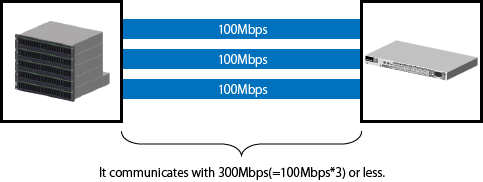
Improved Fault-Resilience
When a communication fault occurs in any one of the bundled networks, the remaining networks can continue communication.
"Figure 6.2 Improved Fault-Resilience" is when one of 3 networks has a fault so the remaining 2 networks continue at a maximum speed of 200 Mbps.
Figure 6.2 Improved Fault-Resilience
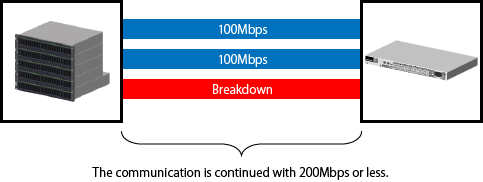
NAS File System Environment
NAS server name
NAS server name is a unique name set within the ETERNUS Disk storage system.
By registering the NAS server name set within the ETERNUS Disk storage system and the DNS server, it is possible to set the NAS server name and access the CIFS protocol shared folder.
DNS server
Sets the DNS server to use when operating NAS.
It is possible to set a maximum of 2 DNS Servers for IPv4 and IPv6 respectively.
Authentication System
With this product, as access to the shared folder is controlled, an authentication system using a domain controller is provided.
The domain controller centrally manages the account information of individual clients on the network, and conducts authentication in relation to each of these clients or permits access.
In case an authentication server goes down, it is possible to register a maximum of 3 authentication servers for each authentication method.
The authentication methods supported by this product are as follows:
Kerberos Authentication Method with Active Directory
Kerberos is a network authentication protocol designed to provide strong authentication for client/server applications. A password received from a client is authenticated, and a ticket is issued. By utilizing the ticket, the client that has been authenticated is able to utilize the network service.
When accessing the shared folder with a CIFS protocol, and when managing access to directories and files, in order to perform authentication and access control using this authentication method, register an Active Directory domain controller.
When accessing the shared folder from multiple domain users/groups, set up an explicit confidential relationship of an authentication server. This makes it possible for other domain users/groups for which an explicit confidential relationship is set up with the registered authentication server to access the shared folder.
Authentication Method using LDAP
LDAP is a protocol for accessing the directory service. With the directory service, it is possible to easily use features such as the search function by centrally managing the account information of network equipment and clients.
When accessing the shared folder with the NFS protocol, and when performing access management to directories and files, in order to perform authentication and access control using this authentication method, register an LDAP server.
This section explains an overview of backup of the NAS environment in the ETERNUS Disk storage system.
See
Refer to "Backup of NAS Environment" in the AdvancedCopy Manager Operation Guide for Copy Control Module for information on the backup operation for NAS environment.
It is possible to back up the entire NAS volume configured with Web Console to a NAS backup volume. In addition, it is possible to restore the entire NAS volume from the NAS backup volume.
Figure 6.3 Backup/Restoration of NAS Volume
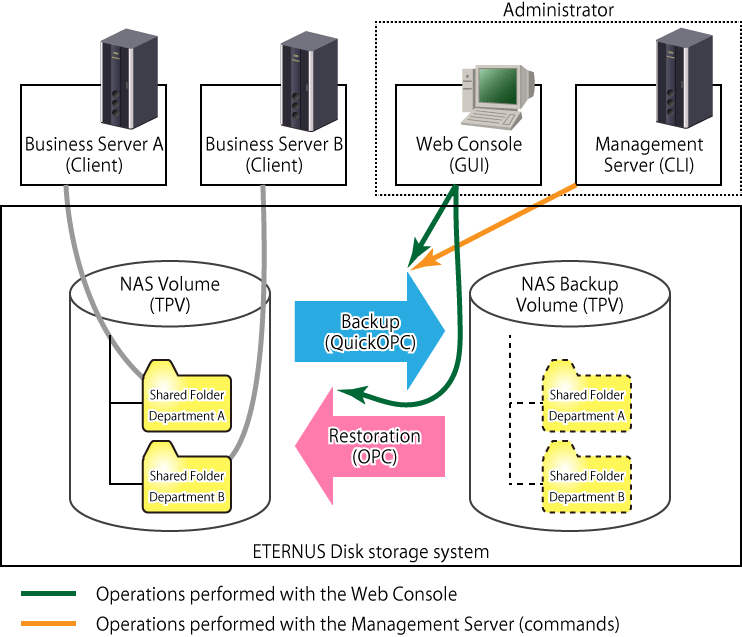
Information
Backup / restore of the NAS volume can either be executed with Web Console, or be executed with commands from the Management Server.
When recovering individual files from the NAS backup volume, mount the NAS backup volume and manually copy the files.
The number of NAS volumes and NAS backup volumes creatable on one ETERNUS Disk storage system varies with the device model and its firmware version. Refer to the ETERNUS Disk storage system manuals for details.
The NAS backup volume that is the backup destination of the NAS volume can be mounted onto the NAS environment as Read-Only. By mounting the NAS backup volume, users can recover files themselves. In addition, a mounted NAS backup volume can be unmounted when recovery has been completed.
Figure 6.4 Mounting/Unmounting the NAS Backup Volume
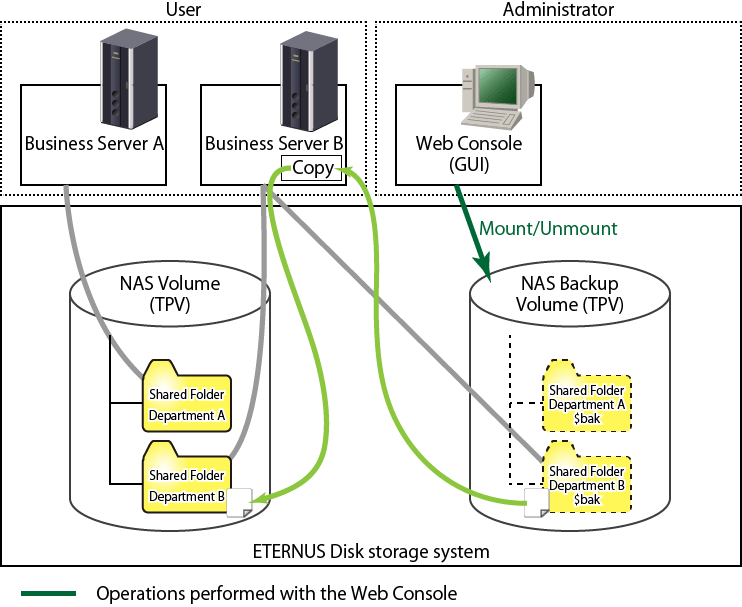
Information
Mounting and unmounting of the NAS backup volume can be done from Web Console.
While the NAS backup volume is mounted, it is not possible to backup or restore the NAS volume.
When accessing the shared folder in the NAS backup volume after mounting with the CIFS protocol, the name of the shared folder is "the name of the shared folder at the time of backup" + "$bak". Furthermore, the name of the shared folder of the NAS backup volume is not displayed in Web Console.
This section provides an outline of the NAS environment snapshot function for the ETERNUS Disk storage system.
NAS snapshots can be periodically captured and the captured snapshots can be browsed by a snapshot captured client. The NAS volume snapshot is achieved using SnapOPC+. This is provided for the purposes of NAS volume generation management and to be able to recover files and folders deleted due to operating errors.
The NAS snapshot feature can be used by configuring the snapshot from Web Console.
Point
There are two modes in NAS snapshot of NAS volumes: Automatic and Manual. In this product, Automatic mode can be set up/changed/cancelled.
To set up/change/cancel Manual mode that captures snapshots at any timing, refer to the ETERNUS Disk storage system manuals.
The following items are configured:
Snapshot generation number
Set the number of snapshot generations for that you want to own.
The settable number of NAS snapshot generations varies with the device model and firmware version number, and with the total number of NAS snapshot generations specified for a target device. Set a value in this item for a target device so that the maximum settable number of NAS snapshot generations is not exceeded.
The total number of NAS snapshot generations specified for a device means the sum of NAS snapshot generations set for all the NAS volumes in the device. The number of generations includes the number of generations taken in Automatic mode and the number of generations taken in Manual mode, as well. Refer to the NAS snapshot specification described in the ETERNUS Disk storage system manual for details.
Schedule configuration
Sets the schedule for capturing the snapshots. A snapshot is taken on the day set every week or the hour set every day.
Figure 6.5 Outline of NAS Snapshot
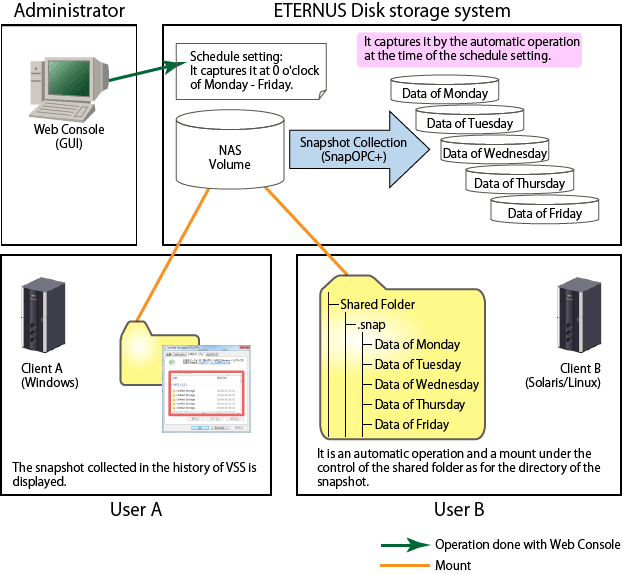
Note
If a snapshot is collected while accessing a volume from an application, a snapshot at a point in time at which half-done data was written to the volume could be created. In this case, the data consistency in the snapshot is not ensured, so that the operation of the file in the snapshot is made impossible or the file content becomes incomplete.
Generally, to collect a snapshot whose data is consistent, the application accessing a volume must be stopped beforehand.
Configure a schedule for snapshot collection and the number of generations in a snapshot so that correct data can be traced back through generations when data inconsistency is found in the snapshot.
Where the NAS volume is temporarily not updated due to device maintenance period or long break, overwriting of past snapshots can be prevented by stopping the automatic snapshot collection. When restarting the automatic snapshot collection, execute automatic snapshot collection start. Automatic snapshot collection can be restarted carrying on with the snapshot before stopping.
Figure 6.6 Automatic Snapshot Collection Stop/Start
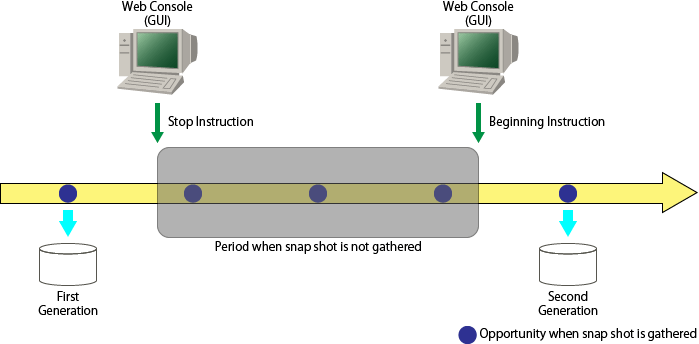
This section provides an outline of NAS environment quota management for the ETERNUS Disk storage system.
With quota management, the amount of usable resources can be limited. This prevents the depletion of the whole system resources that is caused by disk capacity being consumed away by some users/groups or on some shared folders.
When accessing a shared folder with CIFS protocol, disk usage and the number of files can be limited for the users and shared folders.
When accessing a shared folder with NFS protocol, disk usage and the number of files can be limited for the users, groups, and shared folders.
The following two values can be set:
Limit value
This is the upper limit value actually used. When updating data that exceeds the limit value, there is an error for the update.
Warning value
This is the value for providing pre-notification before reaching the limit value. When updating data that has exceeded the warning value, an SNMP Trap and event shall be notified to the Management Server.
Point
Quota can be set for the user/group and shared folder at the same time. There is no order of priority in settings, and control is executed by a warning value or limit value that is reached first.
Even if a disk is used with a limit value exceeded, it may not cause any error. In this case, it is used up to disk use amount limitation value + 2 GB in the maximum.
When a NAS volume to which quota is set is backed up, its quota setting information is backed up at the same time. For this reason, when it is restored, its quota setting information backed up is applied.
Note
When using the quota management function, enable SNMP Trap settings. If they are not enabled, no alarm notification is output when a quota threshold is exceeded.
To change SNMP Trap settings on Web Console, refer to "Change ETERNUS Disk Storage System Information" in the Web Console Guide.
Figure 6.7 Quota Management Outline
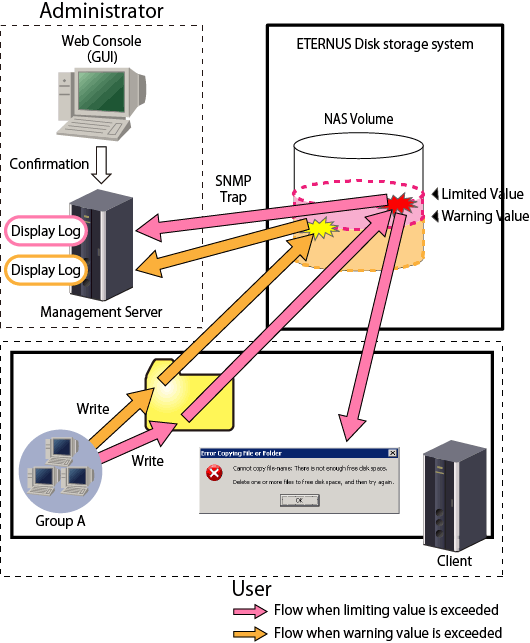
Information
Sets a quota for the users/groups or shared folders registered on the authentication server set in "6.6.3.3 NAS File System Environment Settings".
By using mail notification and Systemwalker Centric Manager linkup feature, you are notified by E-mail when the quota management limit value or warning value are exceeded. Refer to "6.3 Event Display and Linkage" for details.
With quota management, an SNMP Trap is notified by the Management Server in the following cases.
Error occurred when data update or file creation was attempted with the limit value reached (Limit value exceeded)
Warning value exceeded (predicted)
Returned below warning value
The notified event can be confirmed on the quota management log screen on Web Console. Logs are stored for 30 days.
See
Refer to "Display Quota Information" in the Web Console Guide for the procedure to display the Quota Management Log screen.
Point
Events are categorized by type; warning value exceeded, limit value exceeded, warning value removed, and notified every 10 minutes.
The limit value exceeded event is notified when an error occurred because data update or file creation was attempted with a limit value reached.
The functions of the NAS option of the ETERNUS Disk storage system can be used with the following environments.
Object | Environment |
|---|---|
Platform | Platforms on which the ETERNUS SF Manager can be operated. |
Required licenses (software) |
|
ETERNUS Disk storage system | ETERNUS DX100 S5/DX200 S5, DX500 S5/DX600 S5 |
Required options (hardware) | NAS Option |
Agent | Storage Cruiser's agent is not required. |
Authentication methods (*4) | When accessing with the CIFS protocol: Active Directory |
*1: Required to construct the NAS file system.
*2: Required to back up the NAS volumes.
*3: Required to register either one.
*4: Required when performing access control using an authentication server for the NAS file system. When no authentication server is configured, all accesses are permitted.